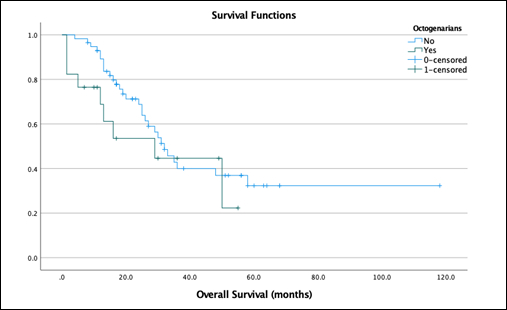Introduction: A great deal of doubt and fear surrounds pancreatectomy for PDAC in octogenarians, because of allegedly worse perioperative outcome and long-term prognosis.
Methods: Analysis and comparison of clinical, perioperative characteristics and overall survival (OS) was performed among octogenarians (>80 years old) and hexagenerians (60-70 years old) undergoing pancreatectomy for PDAC in our pancreas referral center (Feb. 2014 - Jun 2023). Descriptive statistics, X2, t-tests, linear regressions and Cox Regressions for Overall Survival (OS) were utilized for statistical analysis.
Results: Two groups of patients were included, 21 octogenarians (80-87 years of age) and 57 hexagenerians (60-69 years of age). Location of the tumor (head, uncinate, neck, body, tail) (p=0.82), type of pancreatectomy (Whipple, Distal, Total) (p=0.27), clinical staging (upfront resectable, borderline resectable, locally advanced) (p=0.08), administration of adjuvant therapy (p=0.98) and need for portal/superior mesenteric vein resection (p=0.12) did not differ between the two groups. Median duration of ICU stay was 0 days in both groups (p=0.3), and length of hospital stay was 8 days (p=0.95) in both groups. Mortality was higher among octogenarians (14%), but all 3 patients who died had ECOG-PS:3, and no octogenarians with ECOG-PS: < 2 died. Hexagenerians (all with ECOG-PS: < 2) had a mortality of 2%. Patients with ECOG-PS: < 2 had a median OS of 17 months (IQR: 11-35) in the octogenarian group and 24 months (IQR: 15-36) in the hexagenerian group (p=0.96).
Conclusion: Age of more than 80 years associated with ECOG-PS < 2 did not adversely affect clinical outcomes and overall survival after pancreatectomy for PDAC when compared with age 60-70 years. Octogenarians should not be prevented from undergoing a pancreatectomy based on their age alone.

Figure 1: Kaplan-Meier curves depicting the Overall Survival (OS) between the two groups of patients. OS is comparable between octagenarians (>80years old) and hexagenarians (60-69years old).